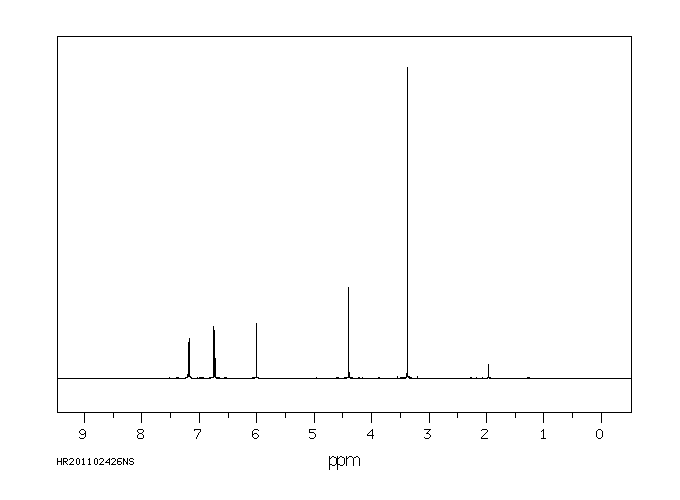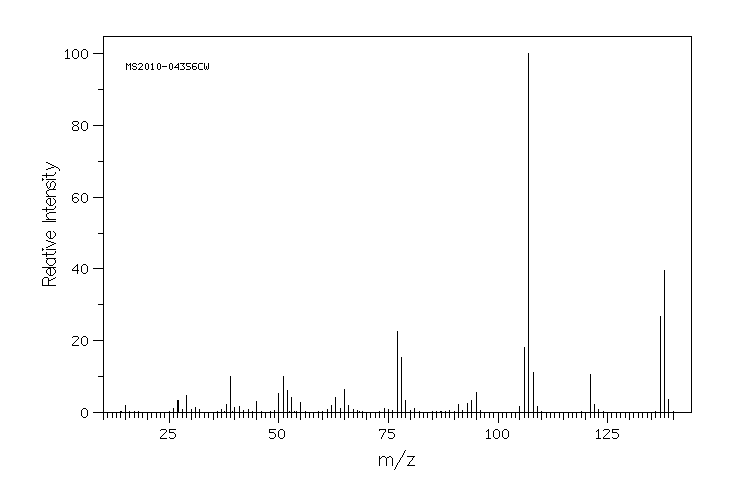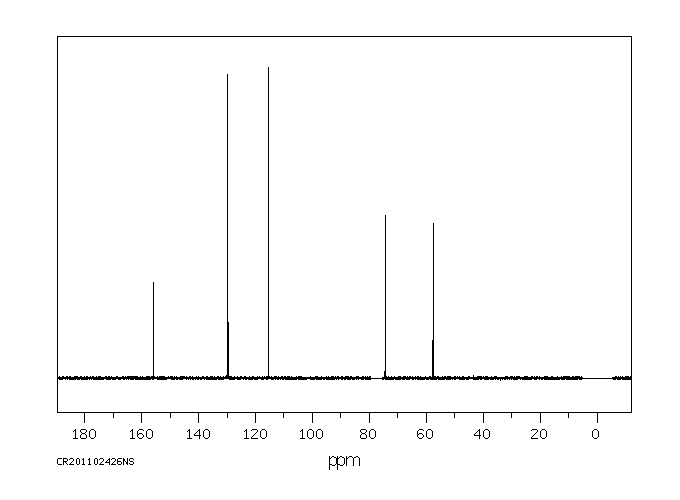4-甲氧甲基苯酚 | 5355-17-9
物质功能分类
中文名称
4-甲氧甲基苯酚
中文别名
4-(甲氧基甲基)苯酚
英文名称
4-hydroxybenzyl methyl ether
英文别名
4-(Methoxymethyl)phenol
CAS
5355-17-9
化学式
C8H10O2
mdl
——
分子量
138.166
InChiKey
AHXXIALEMINDAW-UHFFFAOYSA-N
BEILSTEIN
——
EINECS
——
-
物化性质
-
计算性质
-
ADMET
-
安全信息
-
SDS
-
制备方法与用途
-
上下游信息
-
文献信息
-
表征谱图
-
同类化合物
-
相关功能分类
-
相关结构分类
物化性质
-
熔点:82.5-83.5 °C
-
沸点:147-153 °C(Press: 11 Torr)
-
密度:1.5319 g/cm3(Temp: 24 °C)
-
LogP:1.190 (est)
-
保留指数:1306
计算性质
-
辛醇/水分配系数(LogP):0.8
-
重原子数:10
-
可旋转键数:2
-
环数:1.0
-
sp3杂化的碳原子比例:0.25
-
拓扑面积:29.5
-
氢给体数:1
-
氢受体数:2
安全信息
-
海关编码:2909500000
-
危险性防范说明:P280,P305+P351+P338
-
危险性描述:H302
-
储存条件:室温且干燥
SDS
Section 1. IDENTIFICATION OF THE SUBSTANCE/MIXTURE
Product identifiers
Product name : N,N'-BIS(P-TOLUENESULFONYL)HYDRAZINE
Section 2. HAZARDS IDENTIFICATION
Classification of the substance or mixture
Classification according to Regulation (EC) No 1272/2008 [EU-GHS/CLP]
Acute toxicity, Oral (Category 4)
Classification according to EU Directives 67/548/EEC or 1999/45/EC
Harmful if swallowed.
Label elements
Labelling according Regulation (EC) No 1272/2008 [CLP]
Pictogram
Signal word Warning
Hazard statement(s)
Harmful if swallowed.
Precautionary statement(s) none
Supplemental Hazard none
Statements
According to European Directive 67/548/EEC as amended.
Hazard symbol(s)
R-phrase(s)
R22 Harmful if swallowed.
S-phrase(s) none
Caution - substance not yet tested completely.
Other hazards - none
Section 3. COMPOSITION/INFORMATION ON INGREDIENTS
Substances
Formula : C8H10O2
Molecular Weight : 138,17 g/mol
Component Concentration
N,N'-BIS(P-TOLUENESULFONYL)HYDRAZINE
-
Section 4. FIRST AID MEASURES
Description of first aid measures
General advice
Consult a physician. Show this safety data sheet to the doctor in attendance.
If inhaled
If breathed in, move person into fresh air. If not breathing, give artificial respiration. Consult a physician.
In case of skin contact
Wash off with soap and plenty of water. Consult a physician.
In case of eye contact
Flush eyes with water as a precaution.
If swallowed
Never give anything by mouth to an unconscious person. Rinse mouth with water. Consult a physician.
Most important symptoms and effects, both acute and delayed
To the best of our knowledge, the chemical, physical, and toxicological properties have not been thoroughly
investigated.
Indication of any immediate medical attention and special treatment needed
no data available
Section 5. FIRE-FIGHTING MEASURES
Extinguishing media
Suitable extinguishing media
Use water spray, alcohol-resistant foam, dry chemical or carbon dioxide.
Special hazards arising from the substance or mixture
Carbon oxides
Advice for firefighters
Wear self contained breathing apparatus for fire fighting if necessary.
Further information
no data available
Section 6. ACCIDENTAL RELEASE MEASURES
Personal precautions, protective equipment and emergency procedures
Use personal protective equipment. Avoid dust formation. Avoid breathing vapors, mist or gas. Ensure
adequate ventilation. Avoid breathing dust.
Environmental precautions
Do not let product enter drains.
Methods and materials for containment and cleaning up
Pick up and arrange disposal without creating dust. Sweep up and shovel. Keep in suitable, closed
containers for disposal.
Reference to other sections
For disposal see section 13.
Section 7. HANDLING AND STORAGE
Precautions for safe handling
Avoid contact with skin and eyes. Avoid formation of dust and aerosols.
Provide appropriate exhaust ventilation at places where dust is formed.Normal measures for preventive fire
protection.
Conditions for safe storage, including any incompatibilities
Store in cool place. Keep container tightly closed in a dry and well-ventilated place.
Specific end uses
no data available
Section 8. EXPOSURE CONTROLS/PERSONAL PROTECTION
Control parameters
Components with workplace control parameters
Exposure controls
Appropriate engineering controls
Handle in accordance with good industrial hygiene and safety practice. Wash hands before breaks and at
the end of workday.
Personal protective equipment
Eye/face protection
Safety glasses with side-shields conforming to EN166 Use equipment for eye protection tested and
approved under appropriate government standards such as NIOSH (US) or EN 166(EU).
Skin protection
Handle with gloves. Gloves must be inspected prior to use. Use proper glove removal technique
(without touching glove's outer surface) to avoid skin contact with this product. Dispose of
contaminated gloves after use in accordance with applicable laws and good laboratory practices.
Wash and dry hands.
The selected protective gloves have to satisfy the specifications of EU Directive 89/686/EEC and the
standard EN 374 derived from it.
Body Protection
Complete suit protecting against chemicals, The type of protective equipment must be selected
according to the concentration and amount of the dangerous substance at the specific workplace.
Respiratory protection
For nuisance exposures use type P95 (US) or type P1 (EU EN 143) particle respirator.For higher
level protection use type OV/AG/P99 (US) or type ABEK-P2 (EU EN 143) respirator cartridges. Use
respirators and components tested and approved under appropriate government standards such as
NIOSH (US) or CEN (EU).
Section 9. PHYSICAL AND CHEMICAL PROPERTIES
Information on basic physical and chemical properties
a) Appearance Form: solid
b) Odour no data available
c) Odour Threshold no data available
d) pH no data available
e) Melting point/freezing no data available
point
f) Initial boiling point and no data available
boiling range
g) Flash point no data available
h) Evaporation rate no data available
i) Flammability (solid, gas) no data available
j) Upper/lower no data available
flammability or
explosive limits
k) Vapour pressure no data available
l) Vapour density no data available
m) Relative density no data available
n) Water solubility no data available
o) Partition coefficient: n- log Pow: 1,753
octanol/water
p) Autoignition no data available
temperature
q) Decomposition no data available
temperature
r) Viscosity no data available
s) Explosive properties no data available
t) Oxidizing properties no data available
Other safety information
no data available
Section 10. STABILITY AND REACTIVITY
Reactivity
no data available
Chemical stability
no data available
Possibility of hazardous reactions
no data available
Conditions to avoid
no data available
Incompatible materials
Strong oxidizing agents
Hazardous decomposition products
Other decomposition products - no data available
Section 11. TOXICOLOGICAL INFORMATION
Information on toxicological effects
Acute toxicity
no data available
Skin corrosion/irritation
no data available
Serious eye damage/eye irritation
Respiratory or skin sensitization
Will not occur
Germ cell mutagenicity
no data available
Carcinogenicity
IARC: No component of this product present at levels greater than or equal to 0.1% is identified as
probable, possible or confirmed human carcinogen by IARC.
Reproductive toxicity
no data available
Specific target organ toxicity - single exposure
no data available
Specific target organ toxicity - repeated exposure
no data available
Aspiration hazard
no data available
Potential health effects
Inhalation May be harmful if inhaled. May cause respiratory tract irritation.
Ingestion Harmful if swallowed.
Skin May be harmful if absorbed through skin. May cause skin irritation.
Eyes May cause eye irritation.
Signs and Symptoms of Exposure
To the best of our knowledge, the chemical, physical, and toxicological properties have not been thoroughly
investigated.
Additional Information
RTECS: Not available
Section 12. ECOLOGICAL INFORMATION
Toxicity
no data available
Persistence and degradability
no data available
Bioaccumulative potential
no data available
Mobility in soil
no data available
Results of PBT and vPvB assessment
no data available
Other adverse effects
no data available
Section 13. DISPOSAL CONSIDERATIONS
Waste treatment methods
Product
Offer surplus and non-recyclable solutions to a licensed disposal company. Contact a licensed professional
waste disposal service to dispose of this material. Dissolve or mix the material with a combustible solvent
and burn in a chemical incinerator equipped with an afterburner and scrubber.
Contaminated packaging
Dispose of as unused product.
Section 14. TRANSPORT INFORMATION
UN number
ADR/RID: - IMDG: - IATA: -
UN proper shipping name
ADR/RID: Not dangerous goods
IMDG: Not dangerous goods
IATA: Not dangerous goods
Transport hazard class(es)
ADR/RID: - IMDG: - IATA: -
Packaging group
ADR/RID: - IMDG: - IATA: -
Environmental hazards
ADR/RID: no IMDG Marine pollutant: no IATA: no
Special precautions for user
no data available
Section 15. REGULATORY INFORMATION
This safety datasheet complies with the requirements of Regulation (EC) No. 1907/2006.
Safety, health and environmental regulations/legislation specific for the substance or mixture
no data available
Chemical Safety Assessment
SECTION 16 - ADDITIONAL INFORMATION
N/A
上下游信息
-
上游原料
中文名称 英文名称 CAS号 化学式 分子量 对羟基苯甲醇 (4-hydroxyphenyl)methanol 623-05-2 C7H8O2 124.139 —— 4-hydroxybenzyl acetate 80767-12-0 C9H10O3 166.177 对甲酚 p-cresol 106-44-5 C7H8O 108.14 —— 4-(acetyloxy)benzyl acetate 2937-64-6 C11H12O4 208.214 对羟基苯甲醛 4-hydroxy-benzaldehyde 123-08-0 C7H6O2 122.123 -
下游产品
中文名称 英文名称 CAS号 化学式 分子量 对羟基苯甲酸甲酯 methyl 4-hydroxybenzoate 99-76-3 C8H8O3 152.15 对羟基苯甲醛 4-hydroxy-benzaldehyde 123-08-0 C7H6O2 122.123
反应信息
-
作为反应物:描述:4-甲氧甲基苯酚 在 lithium hydroxide 、 potassium tert-butylate 、 caesium carbonate 、 1-羟基苯并三唑一水物 、 盐酸-N-乙基-Nˊ-(3-二甲氨基丙基)碳二亚胺 、 三乙胺 作用下, 以 四氢呋喃 、 N,N-二甲基甲酰胺 为溶剂, 反应 18.5h, 生成 4-[4-(methoxymethyl)phenoxy]-N-methylthieno[2,3-c]pyridine-2-carboxamide参考文献:名称:Selective Inhibition of ICAM-1 and E-Selectin Expression in Human Endothelial Cells. 2. Aryl Modifications of 4-(Aryloxy)thieno[2,3-c]pyridines with Fine-Tuning at C-2 Carbamides摘要:The elevated expression of cell adhesion molecules (CAMs) on the lumenal surface of vascular endothelial cells is a critical early event in the complex inflammatory process. The adhesive interactions of these CAMs that include E-selectin, ICAM-1, and VCAM-1 with their counterreceptors on leukocytes, such as integrins of the alpha (L)beta (2) family, result in migration of the leukocytes to the site of inflammation and cause tissue injury. Pharmaceutical agents that could suppress the induced expression of one or more of these cell adhesion molecules would provide a novel mechanism to attenuate the inflammatory responses associated with chronic inflammatory diseases. A-205804 (1), a potent and selective inhibitor of the induced expression of E-selectin and ICAM-1 over VCAM-1, was further modified with emphasis at the C-4 and C-2 positions to identify a more potent drug candidate with a good pharmacokinetic profile and physical properties. Replacement of the C-4 sulfur linkage in I with an oxygen atom eliminated one of the two major metabolites for this lead molecule. The para-position of the 4-phenoxy group of the thieno[2,3-c]pyridine lead is found to be very critical for a higher in vitro potency and selectivity of E-selectin and ICAM-1 over VCAM-1 expression. This position is presumably close to the solvent-accessible region of the target protein-inhibitor complex. An attempt to install a water-solubilizing group at the para-position of the phenoxy group to increase the aqueous solubility of this lead series through various linkages failed to provide an ideal inhibitor. Only small substituents such as fluorine are tolerated at the meta- and ortho-positions of the 4-phenoxy to retain a good in vitro potency. Bromo, trifluoromethyl, pyrazol-1-yl, and imidazol-1-yl are among the better substituents at the para-position. With fine-tuning at the C-2 position we discovered a series of very potent (IC50 < 5 nM for ICAM-1) and selective (> 200-fold vs VCAM-1) inhibitors with a good pharmacokinetic profile. Demonstrated efficacy in a rat rheumatoid arthritis model and in a mice asthma model with selected compounds is also reported.DOI:10.1021/jm0101702
-
作为产物:描述:对甲酚 在 5%-palladium/activated carbon 、 potassium acetate 、 sodium hydroxide 作用下, 以 水 为溶剂, 反应 12.33h, 生成 4-甲氧甲基苯酚参考文献:名称:Practical Process for the Air Oxidation of Cresols: Part A. Mechanistic Investigations摘要:The catalytic air oxidation of p-cresol and 2,6-di-tert-butyl-4-methylphenol to the corresponding benzaldehydes was investigated to determine the mechanism at work in these oxidation reactions. A number of intermediates and byproducts, mainly in the form of dimers, were observed during the course of the reactions, and their structures were elucidated by spectroscopic and chromatographic methods. The existence of these compounds in the reaction mixtures, and their proposed methods of formation, provided further insight into the mechanism involved in these oxidations.DOI:10.1021/op049845b
文献信息
-
Synthesis of Polysubstituted Bicyclo[3.3.1]nonane-3,7-diones from Cyclohexa-2,5-dienones and Dimethyl 1,3-Acetonedicarboxylate作者:Pelayo Camps、Albert González、Diego Muñoz-Torrero、Montserrat Simon、Adriana Zúñiga、Miriam A. Martins、Mercè Font-Bardia、Xavier SolansDOI:10.1016/s0040-4020(00)00680-3日期:2000.10Oxidation of polysubstituted phenols with phenyliodonium diacetate gives cyclohexa-2,5-dienones, which on reaction with dimethyl 1,3-acetonedicarboxylate afford double-Michael-addition derivatives, whose hydrolysis and decarboxylation provides polysubstituted bicyclo[3.3.1]nonane-3,7-diones. For steric and/or electronic reasons, the Michael reaction only works with 3,5-unsubstituted or 3-substituted
-
Réactions rétrodiéniques—XI作者:M.C. Lasne、J.L. Ripoll、J.M. DenisDOI:10.1016/s0040-4020(01)92422-6日期:1981.1polyunsaturated ketones and hydrocarbons 1–5 for which NMR, IR and UV spectra at low temperature are reported. The Diels—Alder adducts of compounds 1–3 with various dienes, the 1,6 additions of several nucleophilic agents with 4, and the isomerisation of 5 in p-ethynylstyrene support the proposed structures.
-
Reactivity of new precursors of quinone methides作者:Bernard Loubinoux、Joseph Miazimbakana、Philippe GerardinDOI:10.1016/s0040-4039(00)99619-9日期:1989.1The azidomethylene protecting group allows the synthesis of unstable phenolic compounds which are used as quinone methide precursors in the alkylations of alcohols, phenols, azide, thiophenol, amines, enols and enolates.
-
Studies on the syntheses of analgesics. XLVI. An abnormal hofmann degradation of N-(4-hydroxybenzyl)-3-benzazocinium halides (Studies on the syntheses of heterocyclic compounds. DCLXVIII).作者:TETSUJI KAMETANI、KAZUO KIGASAWA、MINEHARU HIIRAGI、KIKUO WAKISAKA、TSUNEO URYU、HIDEO SUGI、SETSU SAITOH、HARUHIDE ISHIMARU、SEIJI HAGADOI:10.1248/cpb.24.1246日期:——N-(4-Hydroxybenzyl)-3-benzazocine (II) and its similar compounds (I, III, and IV) were prepared by two routes, and selective N-debenzylation of the quaternary salts (II and III) of the benzazocines (VIII and IX) was achieved under a Hofmann degradation condition to give pentazocine (V). A normal Hofmann degradation is also described.
-
一种用于成像和治疗的过氧化氢响应性化合物及其合成方法申请人:中国人民解放军陆军军医大学公开号:CN111635389B公开(公告)日:2023-06-27
表征谱图
-
氢谱1HNMR
-
质谱MS
-
碳谱13CNMR
-
红外IR
-
拉曼Raman
-
峰位数据
-
峰位匹配
-
表征信息
同类化合物
(βS)-β-氨基-4-(4-羟基苯氧基)-3,5-二碘苯甲丙醇
(S,S)-邻甲苯基-DIPAMP
(S)-(-)-7'-〔4(S)-(苄基)恶唑-2-基]-7-二(3,5-二-叔丁基苯基)膦基-2,2',3,3'-四氢-1,1-螺二氢茚
(S)-盐酸沙丁胺醇
(S)-3-(叔丁基)-4-(2,6-二甲氧基苯基)-2,3-二氢苯并[d][1,3]氧磷杂环戊二烯
(S)-2,2'-双[双(3,5-三氟甲基苯基)膦基]-4,4',6,6'-四甲氧基联苯
(S)-1-[3,5-双(三氟甲基)苯基]-3-[1-(二甲基氨基)-3-甲基丁烷-2-基]硫脲
(R)富马酸托特罗定
(R)-(-)-盐酸尼古地平
(R)-(-)-4,12-双(二苯基膦基)[2.2]对环芳烷(1,5环辛二烯)铑(I)四氟硼酸盐
(R)-(+)-7-双(3,5-二叔丁基苯基)膦基7''-[((6-甲基吡啶-2-基甲基)氨基]-2,2'',3,3''-四氢-1,1''-螺双茚满
(R)-(+)-7-双(3,5-二叔丁基苯基)膦基7''-[(4-叔丁基吡啶-2-基甲基)氨基]-2,2'',3,3''-四氢-1,1''-螺双茚满
(R)-(+)-7-双(3,5-二叔丁基苯基)膦基7''-[(3-甲基吡啶-2-基甲基)氨基]-2,2'',3,3''-四氢-1,1''-螺双茚满
(R)-(+)-4,7-双(3,5-二-叔丁基苯基)膦基-7“-[(吡啶-2-基甲基)氨基]-2,2”,3,3'-四氢1,1'-螺二茚满
(R)-3-(叔丁基)-4-(2,6-二苯氧基苯基)-2,3-二氢苯并[d][1,3]氧杂磷杂环戊烯
(R)-2-[((二苯基膦基)甲基]吡咯烷
(R)-1-[3,5-双(三氟甲基)苯基]-3-[1-(二甲基氨基)-3-甲基丁烷-2-基]硫脲
(N-(4-甲氧基苯基)-N-甲基-3-(1-哌啶基)丙-2-烯酰胺)
(5-溴-2-羟基苯基)-4-氯苯甲酮
(5-溴-2-氯苯基)(4-羟基苯基)甲酮
(5-氧代-3-苯基-2,5-二氢-1,2,3,4-oxatriazol-3-鎓)
(4S,5R)-4-甲基-5-苯基-1,2,3-氧代噻唑烷-2,2-二氧化物-3-羧酸叔丁酯
(4S,4''S)-2,2''-亚环戊基双[4,5-二氢-4-(苯甲基)恶唑]
(4-溴苯基)-[2-氟-4-[6-[甲基(丙-2-烯基)氨基]己氧基]苯基]甲酮
(4-丁氧基苯甲基)三苯基溴化磷
(3aR,8aR)-(-)-4,4,8,8-四(3,5-二甲基苯基)四氢-2,2-二甲基-6-苯基-1,3-二氧戊环[4,5-e]二恶唑磷
(3aR,6aS)-5-氧代六氢环戊基[c]吡咯-2(1H)-羧酸酯
(2Z)-3-[[(4-氯苯基)氨基]-2-氰基丙烯酸乙酯
(2S,3S,5S)-5-(叔丁氧基甲酰氨基)-2-(N-5-噻唑基-甲氧羰基)氨基-1,6-二苯基-3-羟基己烷
(2S,2''S,3S,3''S)-3,3''-二叔丁基-4,4''-双(2,6-二甲氧基苯基)-2,2'',3,3''-四氢-2,2''-联苯并[d][1,3]氧杂磷杂戊环
(2S)-(-)-2-{[[[[3,5-双(氟代甲基)苯基]氨基]硫代甲基]氨基}-N-(二苯基甲基)-N,3,3-三甲基丁酰胺
(2S)-2-[[[[[((1S,2S)-2-氨基环己基]氨基]硫代甲基]氨基]-N-(二苯甲基)-N,3,3-三甲基丁酰胺
(2S)-2-[[[[[[((1R,2R)-2-氨基环己基]氨基]硫代甲基]氨基]-N-(二苯甲基)-N,3,3-三甲基丁酰胺
(2-硝基苯基)磷酸三酰胺
(2,6-二氯苯基)乙酰氯
(2,3-二甲氧基-5-甲基苯基)硼酸
(1S,2S,3S,5S)-5-叠氮基-3-(苯基甲氧基)-2-[(苯基甲氧基)甲基]环戊醇
(1S,2S,3R,5R)-2-(苄氧基)甲基-6-氧杂双环[3.1.0]己-3-醇
(1-(4-氟苯基)环丙基)甲胺盐酸盐
(1-(3-溴苯基)环丁基)甲胺盐酸盐
(1-(2-氯苯基)环丁基)甲胺盐酸盐
(1-(2-氟苯基)环丙基)甲胺盐酸盐
(1-(2,6-二氟苯基)环丙基)甲胺盐酸盐
(-)-去甲基西布曲明
龙蒿油
龙胆酸钠
龙胆酸叔丁酯
龙胆酸
龙胆紫-d6
龙胆紫










